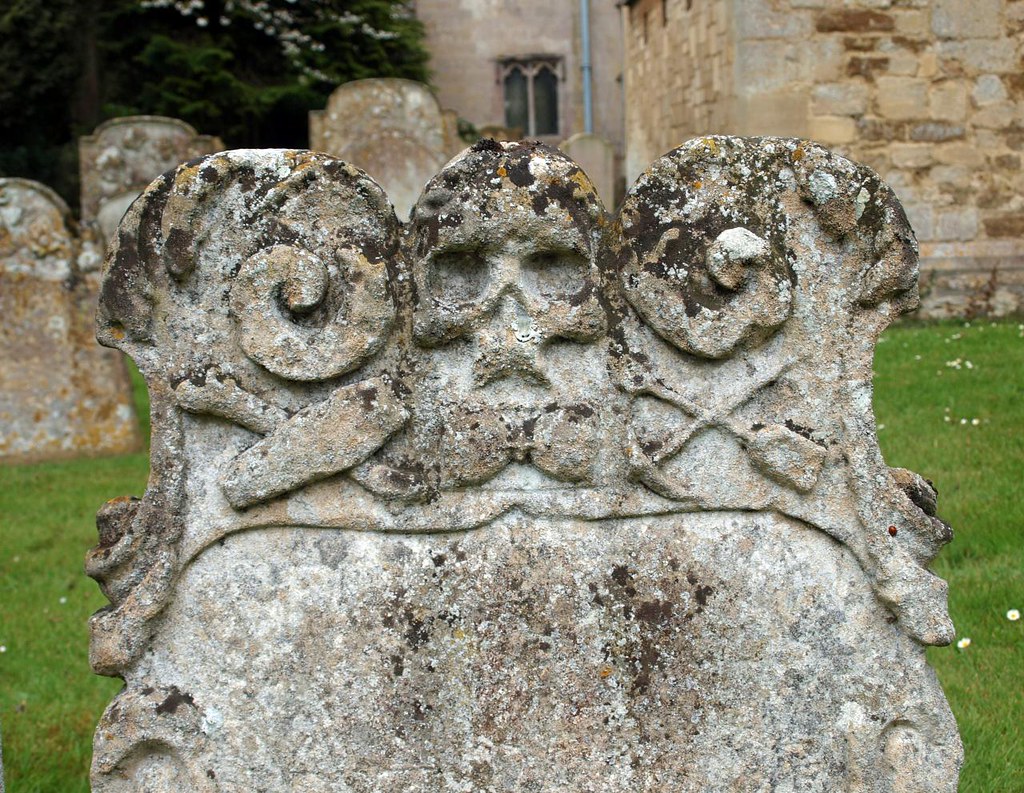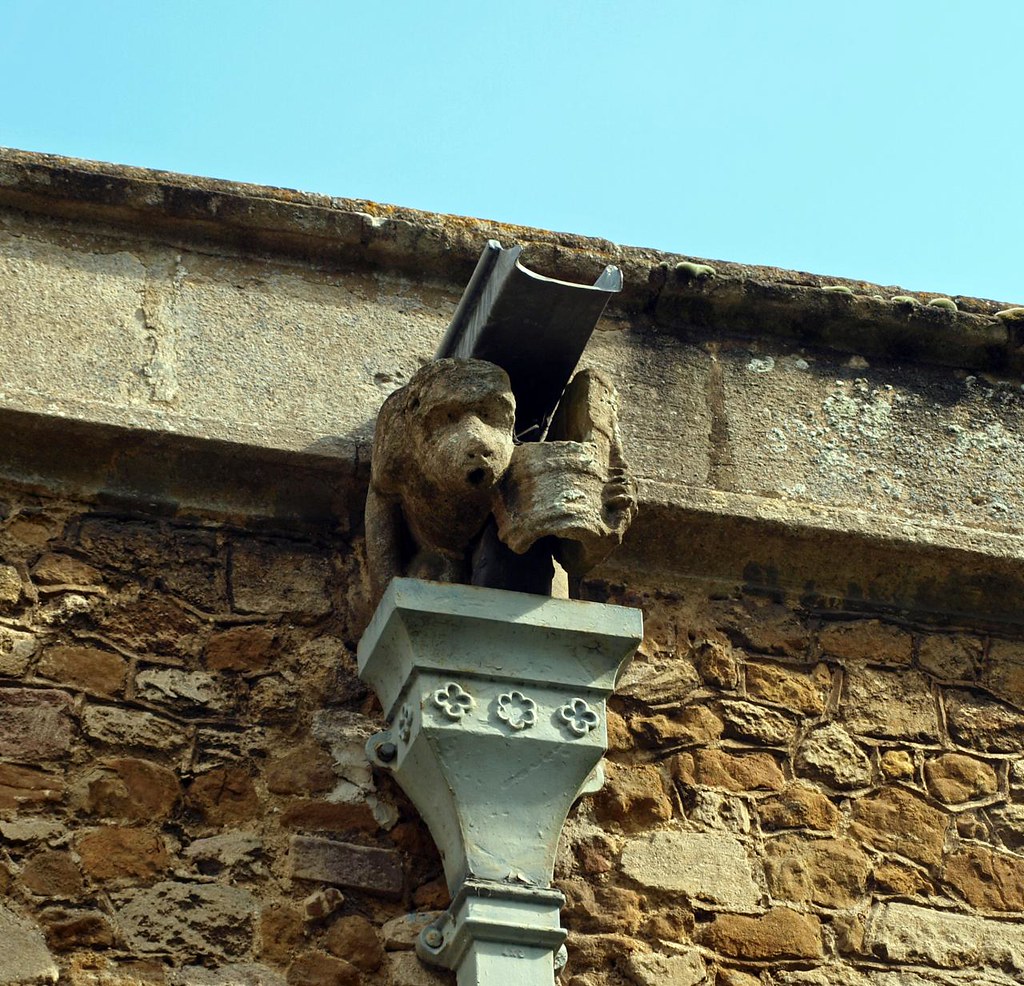Mass was ongoing when I visited so I didn't get inside but was compensated with some great headstones instead; I think it is normally locked with keyholders listed.
HOLY TRINITY. The church looks large and Victorian, but in fact is genuine and only fiercely restored (R. R. Rowe, 1876 etc.). Building went on chiefly in the later C13 and the earlier C14. It seems to have begun at the chancel end (E window by Rowe). Lancet windows on the N and S sides. One two-light window inserted on the S side c. 1300. A little later the transepts, aisles, with arcades, S porch and W tower. The tower was entirely rebuilt by Rowe. But it recalls what must have been interesting work of its date: W doorway with finely moulded surround, W window with reticulated tracery and a surround of one order of ball-flower and one order of dog-tooth, then the next stage with one circular window on each side, also surrounded by ball-flower, then the bell-stage with two single lancets on each side, cusped and not shafted. The top-parts and the slim lead spire were added in the C15. Tower arch towards the nave on triple shafts with moulded capitals. Early C14 also the (removed and re-erected) S porch with doorway on triple-shafts and ogee-headed side openings (altered inside), and the nave arcades with octagonal piers and double-chamfered arches. The piers are continued above the C11 moulded capitals in small broaches dying into the arches. The arches into the transepts are almost round and seem later. The transepts themselves are specially drastically restored; but the S transept E window (two-light and a spherical triangle above) may well be earlier than arcade and W tower. Clerestory and chancel arch remodelled in the C15. - FONT. Octagonal, Perp, four griffins seated against the stem, demi-figures of angels and rosettes on the bowl. - ROOD SCREEN. With single-light divisions. Plain arches and panel tracery above. - MONUMENTS. Low C14 recess in the chancel N wall. - Parts of the canopies of the lost brass to William Noyon d. 1405. - Brass to John Godfrey d. 1I454 and wife; 21 in. figures.


HADDENHAM. Here where Holy Trinity's fine tower marks the highest and most southern village in the Isle of Ely, Ovin the Saxon founded a church in 673, the same year when Queen Etheldreda, to whom he was steward, founded Ely Cathedral. When his queen no longer needed him, Ovin turned to St Chad’s monastery at Lichfield, and Haddenham was left with his cross inscribed “Give, O God, to Ovin Thy light and rest.” For centuries it remained here, the goal of pilgrims, but now, battered and worn, it has found sanctuary at Ely, and there we have seen the old steward’s cross in his queen’s cathedral.
Ovin made Haddenham holy ground, and Hereward the Wake took refuge close by, where Aldreth’s cottages cluster near a windmill. Here came the Conqueror against him, to build the strategic Causeway which carried the Norman soldiers to the conquest of the Isle after a three-year struggle, a half-mythical story told in Kingsley’s Hereward the Wake.
Ovin’s church fell down and the medieval church which took its place at the end of the 13th century has been largely made new, the massive tower rebuilt stone by stone, with its row of little arches supporting the flower-carved parapet, its three rose windows in circles of trailing ballflowers, and a new bishop keeping watch on each side of the grand west doorway where a squirrel nibbles a nut and birds peck among the leafy capitals.
It seems strange to find clear glass without leads lighting the long church, where a medieval kingpost roof covers the nave and a 15th century arch opens into a chancel 200 years older. It has a windowsill sedilia, and a dainty peephole gives a view of the altar from the vestry. The 15th century chancel screen was patched and brought back after spending a generation in a builder’s yard, and the plain font bowl in the south porch was dug up from the churchyard. The fine font used today was made 500 years ago, with angels and Tudor roses round the bowl and caricatures of lions round the base. Two griffins support the carved arches of an Elizabethan altar table in the lady chapel, and a brass of 1454 shows John Godfrey in a little cap and a belted gown, still praying for himself and his wife, whose portrait has disappeared.
Flickr.
Ovin made Haddenham holy ground, and Hereward the Wake took refuge close by, where Aldreth’s cottages cluster near a windmill. Here came the Conqueror against him, to build the strategic Causeway which carried the Norman soldiers to the conquest of the Isle after a three-year struggle, a half-mythical story told in Kingsley’s Hereward the Wake.
Ovin’s church fell down and the medieval church which took its place at the end of the 13th century has been largely made new, the massive tower rebuilt stone by stone, with its row of little arches supporting the flower-carved parapet, its three rose windows in circles of trailing ballflowers, and a new bishop keeping watch on each side of the grand west doorway where a squirrel nibbles a nut and birds peck among the leafy capitals.
It seems strange to find clear glass without leads lighting the long church, where a medieval kingpost roof covers the nave and a 15th century arch opens into a chancel 200 years older. It has a windowsill sedilia, and a dainty peephole gives a view of the altar from the vestry. The 15th century chancel screen was patched and brought back after spending a generation in a builder’s yard, and the plain font bowl in the south porch was dug up from the churchyard. The fine font used today was made 500 years ago, with angels and Tudor roses round the bowl and caricatures of lions round the base. Two griffins support the carved arches of an Elizabethan altar table in the lady chapel, and a brass of 1454 shows John Godfrey in a little cap and a belted gown, still praying for himself and his wife, whose portrait has disappeared.
Flickr.

No comments:
Post a Comment